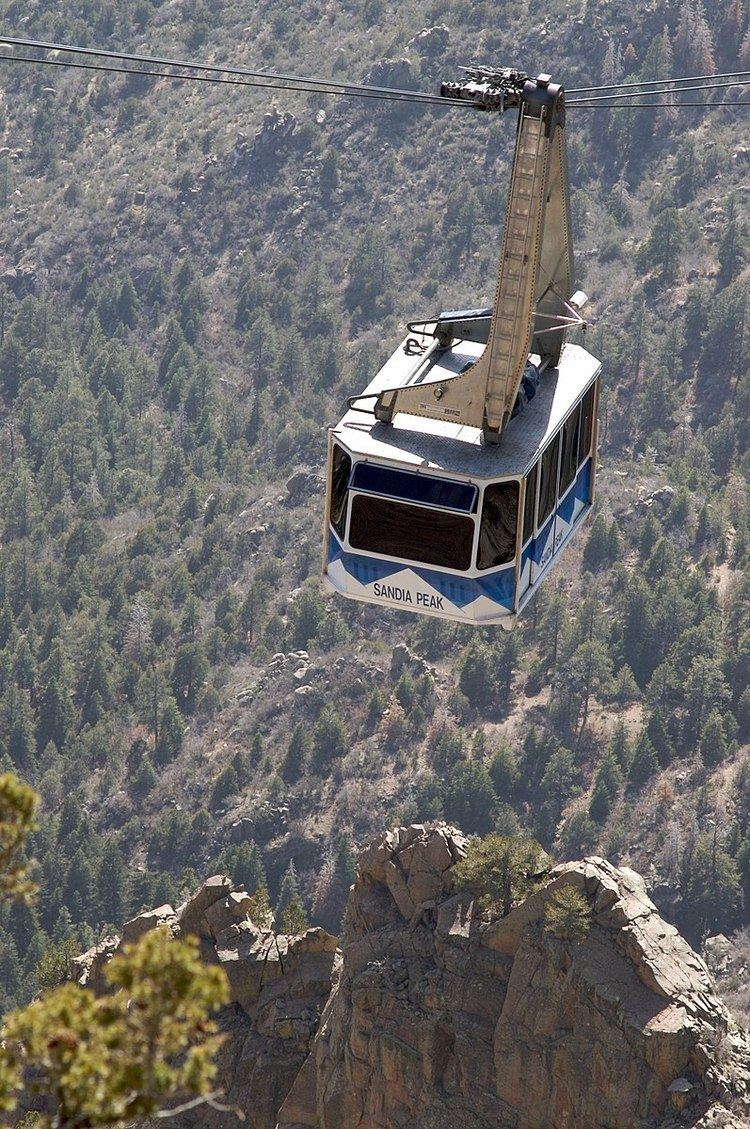Phone +1 505-856-6419 | ||
 | ||
Address Cibola National Forest, 30 Tramway Rd NE, Albuquerque, NM 87122, USA Hours Open today · 5–8PMTuesday5–8PMWednesday9AM–8PMThursday9AM–8PMFriday9AM–8PMSaturday9AM–8PMSunday9AM–8PMMonday9AM–8PMSuggest an edit Similar Sandia Mountains, National Museum of Nuclear S, Indian Pueblo Cultural, Petroglyph National Monument, Albuquerque Biological Park | ||
Sandia peak tramway in hd
The Sandia Peak Tramway is an aerial tramway located adjacent to Albuquerque, New Mexico, USA. It stretches from the northeast edge of the city to the crestline of the Sandia Mountains and has the world's third longest single span. It is the longest aerial tram in the United States.
Contents
- Sandia peak tramway in hd
- My ride sandia peak tramway 2013
- HistoryEdit
- DescriptionEdit
- Activities on topEdit
- References
My ride sandia peak tramway 2013
HistoryEdit
Bell Engineering of Lucerne, Switzerland, constructed the tramway. Entering service on May 7, 1966, the tram makes 10,500 trips per year. The tram is a type known as a "double reversible jigback aerial tramway," where "jigback" implies that when one tram car is ascending, the other is descending. Its two cars are capable of carrying 50 passengers each and have numerous safety and backup systems, such as multiple emergency braking systems and a grounding system that ensures the safety of passengers in the event of a lightning strike. New tram cars were installed in 1986, and new track cables in 2009. New tram cars were again installed in May 2016.
DescriptionEdit
The tramway ascends the steep western side of the highest portion of the Sandia Mountains, from a base elevation of 6,559 feet (1,999 m) to a top elevation of 10,378 feet (3,163 m). A trip up the mountain takes fifteen minutes to ascend 3,819 ft (1,164 m), and the normal operating speed of the tram is 12 miles per hour (19 km/h). Approximately four "flights" leave every hour from the base and top departure stations. The view from the tram includes all of Albuquerque and roughly 11,000 square miles (28,000 square kilometers) of the New Mexico countryside.
The tramway only has two support towers. The first tower, which is 232 feet (70.7 m) tall, is situated at an elevation of 7,010 feet (2,137 m) above sea level and built as an inclined tower with an inclination angle of 18 degrees. The second, just 80 feet (24.4 m) tall, is situated at the end of a major spur of the mountains at an elevation of 8,750 ft (2,667 m) and was built by helicopter aid.
The longest span is between the second tower and the top terminal. This span is the third longest clear tramway span in the world, at a length of 7,720 feet (2,353 m). Mid-span, the cables are 900 ft (274 m) above the mountainside. This span passes over Domingo Baca Canyon, part of which is referred to as TWA Canyon. This is the site of the crash of TWA Flight 260 on February 19, 1955, in which the lives of all 16 passengers and crew were lost. While much of the wreckage was removed during construction of the tramway, some still remains on the canyon floor and may be visible to riders of the tram.
Activities on topEdit
At the top of Sandia Peak there are many year-round recreational options. The High Finance Restaurant is directly adjacent to the top tram terminal and offers scenic views. Many Forest Service trails offer recreational hiking, backpacking and nature hikes to visitors. Additionally, the tram terminal is located at the top of Sandia Peak Ski Area which is on the opposite side of the mountain from the tramway and the city. Skiing is available in the wintertime, and during the summer over 26 miles (42 km) of mountain biking trails are available. Bikes cannot be brought on tram cars. There is no public transportation in this area of Albuquerque; the tram is only accessible by taxi or personal vehicle.
